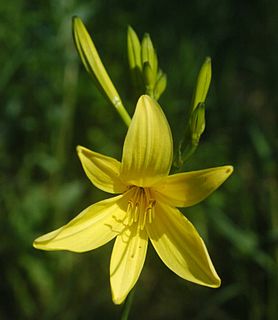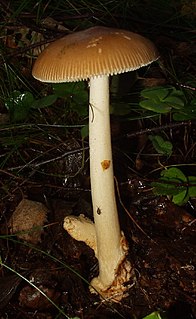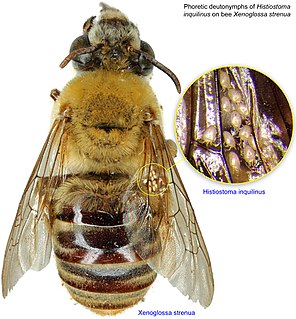
A daylily or day lily is a flowering plant in the genus Hemerocallis, a member of the family Asphodelaceae, subfamily Hemerocallidoideae. Despite the common name, it is not in fact a lily. Gardening enthusiasts and horticulturists have long bred daylily species for their attractive flowers. Thousands of cultivars have been registered by local and international Hemerocallis societies.

Amanita fulva, commonly called the tawny grisette, is a basidiomycete mushroom of the genus Amanita. It is found frequently in deciduous and coniferous forests of Europe, and possibly North America.

Ulmus rubra, the slippery elm, is a species of elm native to eastern North America, ranging from southeast North Dakota, east to Maine and southern Quebec, south to northernmost Florida, and west to eastern Texas, where it thrives in moist uplands, although it will also grow in dry, intermediate soils. Other common names include red elm, gray elm, soft elm, moose elm, and Indian elm. The tree was first named as part of Ulmus americana in 1753, but identified as a separate species, Ulmus rubra, in 1793 by Pennsylvania botanist Gotthilf Muhlenberg. The slightly later name U. fulva, published by French botanist André Michaux in 1803, is still widely used in dietary-supplement and alternative-medicine information.

The cave swallow is a medium-sized, squarish tailed swallow belonging to the same genus as the more familiar and widespread cliff swallow of North America. The cave swallow, also native to the Americas, nests and roosts primarily in caves and sinkholes.

Hemerocallis fulva, the orange day-lily, tawny daylily, corn lily, tiger daylily, fulvous daylily or ditch lily, is a species of daylily native to Asia. It is very widely grown as an ornamental plant in temperate climates for its showy flowers and ease of cultivation. It is not a true lily in the genus Lilium, but gets its name from the superficial similarity of its flowers to Lilium and from the fact that each flower lasts only one day.
Fulvous is a colour, sometimes described as dull orange, brownish-yellow or tawny; it can also be likened to a variation of buff, beige or butterscotch. As an adjective it is used in the names of many species of birds, and occasionally other animals, to describe their appearance. It is also used as in mycology to describe fungi with greater colour specificity, specifically the pigmentation of the surface cuticle, the broken flesh and the spores en masse.

Cephalopholis fulva, the coney or the butterfish, is a species of marine ray-finned fish, a grouper from the subfamily Epinephelinae which is in the family Serranidae which also includes the anthias and sea basses. It is found in the western Atlantic. It is associated with reefs and is a quarry species for commercial and recreational fisheries. It can be found in the aquarium trade.
The Brachypsectridae are a family of beetles commonly known as the Texas beetles. There are only two extant genera, Brachypsectra and Asiopsectra. The type species, Brachypsectra fulva, occurs in North America. Other species in the genus have a cosmopolitan distribution. Two other extant and fossil species have been described from the Dominican Republic. While formerly considered monogeneric, in 2016 Asiopsectra was described from specimens found in Iran and Tajikistan. Two extinct genera, Vetubrachypsectra and Hongipsectra, known from adults, and a larval genus, Cretopsectra are known from Cenomanian aged Burmese amber.

Louisiana iris is a taxonomic group of five iris species native to Louisiana and surrounding regions of the southeastern United States: Iris fulva, Iris hexagona, Iris brevicaulis, Iris giganticaerulea, and Iris nelsonii.

Lomamyia is a genus of beaded lacewings in the family Berothidae. There are about 11 described species in Lomamyia.
Tetraonyx fulva is a species of blister beetle in the family Meloidae. It is found in North America.
Lomamyia squamosa is a species of beaded lacewing in the family Berothidae. It is found in North America.
Lomamyia flavicornis is a species of beaded lacewing in the family Berothidae. It is found in North America.

Nectopsyche is a genus of white millers in the family Leptoceridae. There are at least 60 described species in Nectopsyche.

Mycetina is a genus of handsome fungus beetles in the family Endomychidae. There are about 11 described species in Mycetina.

Xenoglossa is a genus of large squash bees in the family Apidae. There are about 11 described species in Xenoglossa.
Hulstina imitatrix is a species of geometrid moth in the family Geometridae. It is found in North America.
Sibinia fulva is a species of leguminous seed weevil in the beetle family Curculionidae. It is found in North America.
Claassenia is a genus of common stoneflies in the family Perlidae. There are about 12 described species in Claassenia.
Asagena fulva is a species of cobweb spider in the family Theridiidae. It is found in the United States and Mexico.










